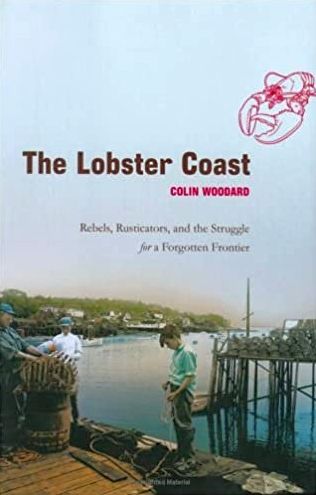
The Lobster Coast, by Colin Woodard

This history of our state is wide in range, from The Lobster Coast: Rebels, Rusticators, and the Struggle for a Forgotten Frontier. A Waterville native, the writer Colin Woodard reached out to numerous coastal specialists and did his research thoroughly. Since I love history, the in-depth footnotes at the end are even fun to peruse and the index helps to guide the reader to the Augusta/Belfast part of the story.
Beginning on Monhegan Island in the first chapter and ending on that pristine island in the last chapter are two beautiful bookends to this rich sea story of fishing and change in the Gulf of Maine. Four centuries of fishing are covered in more detail that I can possibly tell here: various indigenous peoples and many from across the wide Atlantic who fished annually and then finally settled.
Ted Edison, son of the famous inventor,…foresaw a time when cottages, hotels, perhaps golf courses and country clubs might spread all the way to the cliff tops (on Monhegan)…and was willing to donate his own land to preserve the island’s natural beauty and village character.
9/11 apparently even shocked the ever stable lobster market in Maine and at Monhegan. Port Clyde could not offer a daily price for lobster: never happened before…
I especially enjoyed a map on page 55 which shows the distinct fishing areas for the Gulf of Maine: Georges Bank, Brown’s Bank, Cape Sable in Nova Scotia, Bay of Fundy, Penobscot Bay and Cape Cod. What a fishermen’s paradise! No wonder English ships and others repeatedly came to these shores in the early 1600s. The bright blue Atlantic changes to a distinct deep green caused by the Gulf waters containing floating plants of microscopic size.
Lobsters and fish of all kinds feed on the sixty rivers which empty into the Gulf of Maine: the Kennebec, the Sheepscot, and the Androscoggin are among the rivers closest to Belgrade.
Newfoundland fishing was discovered by Cabot in 1497 and followed by cod fishermen from Italy, England, France, Spain (Basque) and Portugal. The Gulf of St. Lawrence was quite the attraction, too.
Captain John Smith of Jamestown fame loved the coast of Maine and he is credited with naming the region New England. “Of all the foure parts of the world that I have seene not inhabited,” he wrote, “I would rather live here than any where.”
Jumping ahead to 1872, Bangor was the greatest lumber city in the world with over one thousand sawmills operating in the state. Granite quarries also sprung up with easy river transport and ocean going vessel delivery around the globe. Even before the great lumber industry, New England shipped 130,000 tons of ice as far as India. So fishing in the Gulf of Maine was not the only economic engine that powered Maine’s prosperity.
The factory freezer trawler shocked me in its size and overfishing capability. To read that not only Russia, but West Germany, Spain, France, Japan and Poland invaded the Georges Bank in the Gulf of Maine with these massive operations was disturbing. Bye-bye fishing abundance in the 1950s as was in existence for centuries: “On Georges, the foreign fleets were so large that observers likened them to great floating cities.”
But why did lobsters prevail or even survive? It was not until quite recently that the video technology was lowered with lobster traps to really view what happens way down there on the bottoms. Baited traps were shown to be attacked by lobsters mounting up like anthills almost immediately when touching bottom.
The lobsters were not trapped! They came and went and dined on the bait like visiting a restaurant. When a trap is pulled up to empty, just those several lobsters at that moment are caught who happen to be dining on the bait. So, for as long as traps have been baited, our lobstermen have been feeding these creatures like farmers feeding cows.
No wonder the lobsters have survived while other fishing has been depleted. Quite a surprise to me and maybe even you.
As with the problems of sprawl and development on land, shoring up Maine’s working waterfronts will require taking a longer view and planning more carefully for the future…At this writing, the incredible abundance of American lobster is holding Maine’s fishing communities together, but as rural Mainers know well, it’s risky to have all of one’s eggs in a single basket.
We need more than lobsters to restore our Gulf of Maine as it once was. Coastal cod, haddock and too many other decimated species of fish offered diversity back in the day and that strength is one we must bring back.
Our poor, backwater state has led the country in everything from recycling bottles to securing health care for low-income citizens, from confronting the excesses of drug companies to enacting policies to reduce greenhouse gas emissions. Our legislators developed laws recognizing key aspects of our lobstermen’s traditional management practices, while scientists and fishermen are adapting cutting-edge technologies to better understand and protect…our fishing industry…
Any librarian or bookseller can recommend books to you for your summer pleasure. I am glad I bought this history because it turned into a lobster story that I did not expect. Learning renews by interest in finding another book about Maine.
Off to Belgrade Public Library, Oliver and Friends Bookstore and maybe even Bull Moose in Waterville. Farmington has two book shops I enjoy as well. Nothing like talking with book people. Better than Zoom for me!
Download Full Newspaper: High Res | Low Res (Details…)
<— Previous Article • Summaries • Next Article —>
©2022 by Summertime in the Belgrades. All rights reserved.